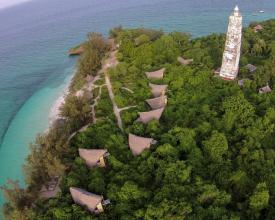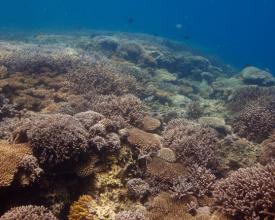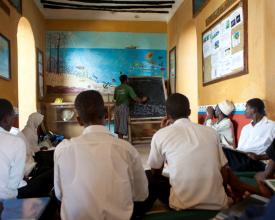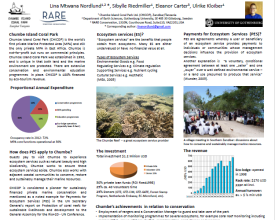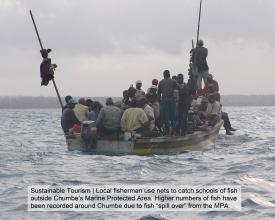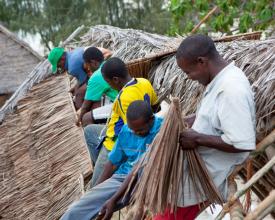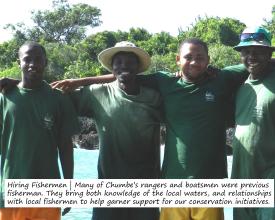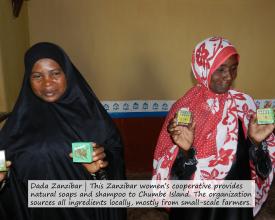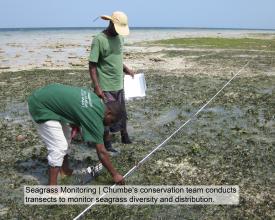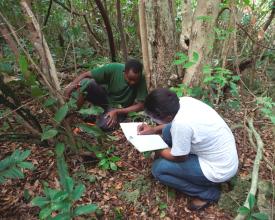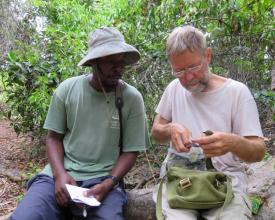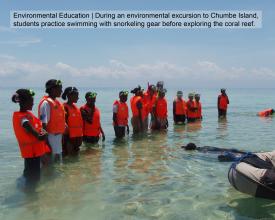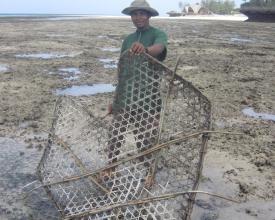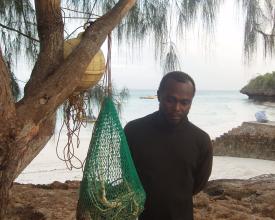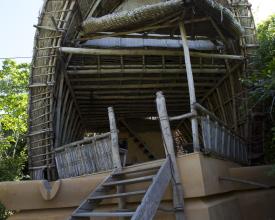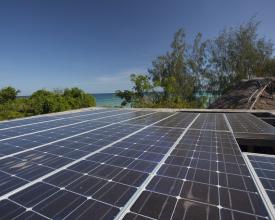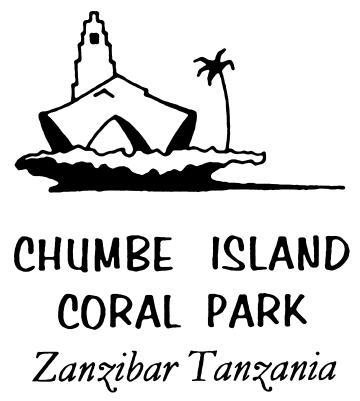Establecimiento de un modelo financieramente sostenible de gestión privada de AMP mediante el ecoturismo

Esta solución aborda la gobernanza de las zonas protegidas, la sobreexplotación de los recursos naturales y la falta de concienciación medioambiental, que son las principales amenazas para la conservación de la biodiversidad y la pesca sostenible en Zanzíbar. CHICOP ha desarrollado un modelo financieramente sostenible de creación y gestión de AMP privadas mediante el ecoturismo que beneficia a las comunidades locales promoviendo la seguridad alimentaria, la pesca sostenible, medios de vida alternativos y aplicando programas de educación ambiental.
Contexto
Défis à relever
Con el rápido crecimiento demográfico y la llegada del turismo de masas a Zanzíbar, los arrecifes de coral están sometidos a la presión de la sobrepesca, la pesca furtiva y los métodos de pesca ilegales, una situación nada infrecuente en los países en desarrollo de los trópicos. La insuficiente capacidad para una gobernanza marina y una aplicación de la ley eficaces, la pobreza y la falta de medios de subsistencia alternativos dificultan el equilibrio entre un medio ambiente y una comunidad sostenibles. La sobreexplotación de los recursos naturales, la falta de conciencia medioambiental y una mala gobernanza marina son los principales retos.
Ubicación
Procesar
Resumen del proceso
El modelo de negocio (building block 1) muestra la innovación y creatividad de este proyecto y pone de manifiesto el modelo de tener ingresos generados por el ecoturismo que se reinvierten en la gestión de las AMP y en programas de educación ambiental. El compromiso y la participación de la comunidad y la maximización del flujo de beneficios (building block 2) son fundamentales para el éxito general de los proyectos, y las comunicaciones claras y transparentes son la base de todo ello. Se aprovechan al máximo los conocimientos científicos (elemento constitutivo 3) para orientar y fundamentar mejor la toma de decisiones en las AMP, y se han incorporado con éxito al enfoque de gestión de las AMP. Para concienciar sobre el valor de los arrecifes de coral, se imparte educación medioambiental a amplios sectores de la sociedad (componente 4), lo que convierte a los turistas en socios de la conservación. La gestión y el cumplimiento efectivos (componente 5) son esenciales para garantizar el buen funcionamiento de las AMP, y han sido clave para el éxito del proyecto. El componente turístico (componente 6) es vital para la sostenibilidad de la AMP y, como centro de aprendizaje, las operaciones turísticas deben ser respetuosas con el medio ambiente. La ecoarquitectura y la tecnología proporcionan un modelo de buenas prácticas para las operaciones de ecoturismo marino y costero en todo el mundo.
Bloques de construcción
El ecoturismo como modelo de AMP privada sin ánimo de lucro
Entre 1991 y 1994, Chumbe Island Coral Park Limited (CHICOP) negoció con éxito con el gobierno semiautónomo de Zanzíbar (Tanzania) que el arrecife de coral y el bosque occidentales de la isla de Chumbe fueran declarados AMP, cuya gestión se encomendó a CHICOP. La empresa se creó específicamente con el fin de desarrollar y gestionar la AMP de forma financieramente autosostenible, utilizando el ecoturismo para generar ingresos para todos los costes operativos de la AMP y las actividades asociadas de conservación, investigación y educación. Gracias a ello, Chumbe se convirtió en el primer parque marino gestionado en Tanzania, la primera AMP gestionada de forma privada en el mundo, y hasta la fecha es una de las únicas AMP autosostenibles económicamente en todo el mundo. Los objetivos de la empresa no tienen ánimo de lucro y llevan más de 20 años aplicando iniciativas de conservación y educación en el marco de dos iteraciones del plan de gestión elaboradas con una amplia participación de las partes interesadas (1995-2005 y 2006-2016). Las operaciones empresariales de ecoturismo siguen principios comerciales para maximizar los ingresos y promover la rentabilidad con el fin de garantizar un flujo de ingresos sostenible para las actividades de las AMP, ejemplificando un enfoque orientado a los negocios de éxito para la gestión sostenible y eficaz de las AMP.
Factores facilitadores
- Adopción de una política de liberalización que permite la vuelta de la inversión extranjera al país, en particular en el sector turístico.
- Aprobación de la Ley de Protección de las Inversiones en 1989 y creación de la Agencia de Inversiones de Zanzíbar en 1991 para examinar las propuestas de inversión
- Compromiso del inversor, determinación, experiencia en gestión de proyectos en Tanzania y capital privado para poner en marcha la iniciativa
- Disponibilidad de voluntarios profesionales y comprometidos
- Disponibilidad de fondos de donantes para componentes no comerciales del proyecto
Lección aprendida
- La gestión privada de una AMP puede ser eficaz y económicamente viable, incluso en un entorno político difícil
- Existe un mercado claro en la industria turística para destinos ecológicos de vanguardia que apoyen principios estrictos de conservación y sostenibilidad.
- No hay necesidad de compromisos La gestión privada tiene grandes incentivos para alcanzar objetivos tangibles de conservación sobre el terreno, cooperar con los usuarios locales de los recursos, generar ingresos, ser rentable y mantener bajos los gastos generales.
- Las inversiones en conservación, tecnologías medioambientales y empleo de personal operativo para la gestión de los parques y los programas educativos aumentan considerablemente los costes, lo que hace más difícil competir con otros destinos turísticos. Un tratamiento fiscal favorable podría fomentar estas inversiones, pero no se concede en Tanzania.
- La seguridad de las inversiones se ve limitada por el hecho de que la tenencia de la tierra sólo es posible mediante arrendamiento, mientras que éste puede ser revocado por el Estado con relativa facilidad, lo que debilita la seguridad de la tenencia a largo plazo.
Participación y beneficios comunitarios
La gestión sostenible de los parques a menudo implica restringir o modificar el acceso a los recursos tradicionales para una gestión sostenible. Por tanto, hay que compensar esos impactos garantizando que las comunidades locales y los usuarios de los recursos se beneficien directa o indirectamente del AMP y participen plenamente en la solución. El AMP de Chumbe se estableció mediante asociaciones participativas con las comunidades locales, e incluyó: reuniones en las aldeas antes y durante el desarrollo del proyecto; empleo y formación de miembros de la comunidad para diversas funciones del proyecto, incluidos antiguos pescadores como guardas del parque; participación de los líderes de las aldeas en los planes de gestión y en las reuniones del Comité Asesor; y la provisión de mayores oportunidades de ingresos para las comunidades locales (como productos agrícolas para el restaurante, materiales de construcción y artesanía, subcontratación de servicios de transporte por carretera y en barco y de artesanos durante el mantenimiento). Además, el proyecto beneficia a las comunidades locales mediante la protección de la valiosa biodiversidad; la repoblación de pesquerías agotadas y arrecifes de coral degradados; el fomento de la concienciación medioambiental entre los pescadores, y la prestación de servicios de emergencia a los pescadores locales en apuros a falta de un servicio de salvamento marítimo en Tanzania.
Factores facilitadores
Las comunidades locales han participado en todo el desarrollo del proyecto, garantizando un compromiso ascendente. El proyecto ha mantenido una comunicación clara y positiva en todo momento, ha animado a las comunidades a participar activamente en las reuniones, ha respetado las tradiciones culturales y ha mantenido un alto nivel de responsabilidad y transparencia en todos los aspectos de sus operaciones. La estrategia de ofrecer oportunidades a quienes quieran aprovecharlas, en lugar de hacer promesas, ha sido clave para el éxito.
Lección aprendida
Las reuniones semestrales del Comité Asesor, a las que asisten los líderes de las aldeas vecinas, han demostrado ser una importante herramienta de comunicación para debatir los objetivos de gestión, los avances del proyecto y otras cuestiones emergentes. Al margen de estas reuniones formales, CHICOP se ha ganado la confianza de las comunidades locales mediante reuniones y diálogos locales informales y constantes, y también ha aprendido de algunos errores, como la comunicación incoherente de los límites de las AMP en los primeros años de su creación, que provocó confusión temporal, enfado y desconfianza entre los pescadores locales. Dado que la concienciación sobre la importancia de los arrecifes de coral era limitada en los primeros años del proyecto, y que el enfoque de las AMP de "zona de exclusión" era un concepto tan nuevo, CHICOP también ha tenido que demostrar activamente cómo el proyecto de las AMP está vinculado a la vida cotidiana de la gente. La religión y la cultura de estas sociedades afectan a todos los aspectos de la vida cotidiana, de ahí que el proyecto también trabaje estrechamente para negociar, explorar y encontrar compromisos en momentos de cualquier disputa.
Recursos
Toma de decisiones basada en la ciencia y desarrollo de capacidades
El establecimiento y la gestión de la AMP se han basado en sólidos fundamentos biofísicos y científicos; desde estudios preliminares de referencia a todos los niveles al inicio del desarrollo conceptual, hasta la supervisión y evaluación periódicas para garantizar un enfoque de gestión adaptable. Desde 1993, CHICOP emplea a biólogos marinos profesionales expatriados como coordinadores de conservación, para formar a los guardas del parque y supervisar todos los programas de investigación y seguimiento. También se han realizado amplios esfuerzos de capacitación interinstitucional en una serie de proyectos tanto dentro de la AMP de Chumbe como con instituciones asociadas y programas emergentes de conservación costera en toda la región. El equipo de guardabosques de CHICOP ha recopilado datos de seguimiento y observación diarios en la AMP, lo que ha llevado a que Chumbe cuente con el conjunto de datos de seguimiento más extenso de cualquier AMP de África, posiblemente del mundo, que abarca más de 20 años de operaciones. Los resultados se utilizan para la toma de decisiones y se comparten a través de una serie de materiales informativos como publicaciones científicas, informes de situación y boletines informativos. Además, todo el personal de CHICOP recibe formación básica sobre ecología forestal y de arrecifes, inglés, ecoturismo y gestión de residuos.
Factores facilitadores
- El desarrollo continuo de las capacidades del personal de las AMP y la disponibilidad de recursos (embarcaciones, combustible, equipos) para llevar a cabo una supervisión eficaz son cruciales.
- Las asociaciones con organizaciones locales y regionales son vitales para facilitar mayores oportunidades de formación.
- Unas metodologías de evaluación adecuadas permiten la recopilación sistemática de datos y la toma de decisiones.
- Los enfoques de gestión adaptativa garantizan que los resultados del seguimiento se evalúen en función de los objetivos y que los programas se adapten a la evolución de los conocimientos.
Lección aprendida
- El seguimiento social y ecológico permite comprender a fondo los impactos de las actividades en el AMP, así como las escalas y frecuencias potenciales de los retos y oportunidades que surjan.
- La eficacia de la gestión de las AMP sólo puede evaluarse si se dispone de datos de seguimiento a largo plazo que aporten pruebas temporales de si se están cumpliendo los objetivos de gestión.
- La gestión adaptativa basada en la ciencia es un proceso muy dinámico de "aprendizaje práctico" que requiere el compromiso de todos los implicados.
- Como el seguimiento lo lleva a cabo personal de Chumbe formado por expertos, aumenta su concienciación medioambiental y les proporciona un sentimiento de propiedad y motivación para proteger los hábitats vigilados.
- Como CHICOP emplea a personas de las comunidades cercanas, que tienen una educación formal y unos conocimientos limitados antes de incorporarse a Chumbe, se ha impartido mucha formación en el puesto de trabajo, lo que ha requerido un tiempo y una inversión considerables.
Programas multinivel de educación y divulgación medioambiental
La comunicación pública, la educación y la concienciación sobre la importancia y vulnerabilidad del ecosistema marino son elementos clave para CHICOP, que ofrece educación medioambiental a pescadores, estudiantes, profesores, funcionarios, operadores turísticos y visitantes. CHICOP aplica la "Educación para el Desarrollo Sostenible" a través de un "Programa de Educación Medioambiental" que desde 1995 ha acogido a más de 6400 escolares, 1100 profesores y 690 miembros de la comunidad en excursiones de campo de un día a la isla de Chumbe. Las excursiones ofrecen actividades prácticas, debates en la propia aula de la isla utilizando herramientas de aprendizaje interactivas, y dispositivos especiales de flotación hacen posible que todos participen en el buceo con tubo, que es especialmente único para las niñas y mujeres musulmanas de la región, que rara vez aprenden a nadar. En colaboración con el Ministerio de Educación, CHICOP ha incorporado un módulo sobre arrecifes de coral a los planes de estudio de las escuelas locales y lleva a cabo cursos de formación de profesores relacionados con la sostenibilidad medioambiental, con el fin de ayudar a crear clubes medioambientales en las escuelas y comunidades de todo Zanzíbar. Estos clubes abordan temas como la gestión de residuos, la pérdida de biodiversidad y proyectos de mitigación del cambio climático.
Factores facilitadores
- Acceso: proximidad de la isla de Chumbe a Zanzíbar.
- El arrecife de la parte occidental de la isla es adecuado para programas educativos.
- Dado que todas las excursiones locales, talleres y actividades educativas asociadas se ofrecen gratuitamente a expensas de CHICOP, los ingresos generados por el ecoturismo financian íntegramente los programas de Educación Ambiental.
- Confianza y buenas relaciones con las instituciones locales (como las escuelas y el Ministerio de Educación) y alumnos de varios niveles.
Lección aprendida
Establecer el programa educativo desde el inicio de las operaciones en Chumbe ha resultado fundamental tanto para el éxito de las iniciativas educativas como para el de la AMP en general. Desde el momento en que se creó la AMP, e incluso antes de que se terminaran las infraestructuras turísticas y comenzaran las operaciones generadoras de ingresos, empezaron los programas escolares, apoyados por fondos privados y subvenciones a pequeña escala. Esto permitió a un amplio sector de la sociedad (escolares, profesores, grupos de pescadores, etc.) visitar y aprender en Chumbe, concienciándose tanto de la importancia y el papel del medio marino en su vida cotidiana como de la importancia de las AMP y los servicios ecosistémicos que prestan los hábitats protegidos de Chumbe. La aplicación sistemática de protocolos de seguridad en todas las actividades proporciona seguridad para que las personas prueben nuevas actividades y aprendan nueva información. El apoyo curricular al Ministerio de Educación ha proporcionado a los niños de Zanzíbar una nueva apreciación del medio marino.
Gestión y aplicación de las AMP
Tras la publicación de la AMP de Chumbe en 1994 por el Gobierno de Zanzíbar, se confió la gestión del Santuario de Arrecifes a CHICOP por un periodo renovable de 10 años (actualmente en su tercer periodo de renovación). Los planes de gestión definen objetivos, actividades, normas de investigación y lo que se debe y no se debe hacer, tanto para los visitantes como para el personal. Sólo se permiten actividades no consuntivas y no explotadoras. La investigación se limita a estudios no extractivos, y están prohibidas la pesca y el fondeo no autorizado en la AMP. El buceo sólo está permitido a investigadores y equipos de rodaje de documentales. Para aumentar la capacidad de hacer cumplir la ley, los guardabosques reciben formación continua en técnicas y procesos de vigilancia para promover y garantizar el cumplimiento de la AMP. Las patrullas se realizan en barco, a pie y desde lo alto del faro. Los guardas no van armados y confían en persuadir a los pescadores y concienciarlos. Los informes diarios de vigilancia se comparten con el Departamento de Desarrollo Pesquero de Zanzíbar. El número de visitantes por día está restringido y sólo las embarcaciones organizadas por Chumbe pueden llevar visitantes a la AMP. Se colocan boyas de demarcación a lo largo de los límites de la AMP y los niveles de cumplimiento son altos, con relaciones positivas con los pescadores locales.
Factores facilitadores
- El marco jurídico permitió el establecimiento de un acuerdo de gestión entre el gobierno y CHICOP.
- El empleo de antiguos pescadores formados en el trabajo y dotados de oportunidades de capacitación, la participación de una amplia gama de interesados y la aplicación de la educación ambiental han creado relaciones positivas con las comunidades locales.
- El pequeño tamaño de la AMP permite un patrullaje eficaz.
- La financiación a largo plazo garantiza la aplicación efectiva de la ley mediante el suministro de equipos y guardas formados a tiempo completo.
Lección aprendida
Chumbe ha sido reconocida como una AMP gestionada eficazmente sobre la base de una serie de criterios biofísicos, sociales y de gobernanza. La clave de una gestión eficaz ha sido la evaluación continua de las actividades en relación con los objetivos de la AMP y la respuesta oportuna a los retos mediante una gestión adaptativa. La lejanía de Chumbe, su tamaño relativamente pequeño y el trabajo comprometido de los guardabosques han contribuido a una aplicación eficaz de la ley y los incidentes de caza furtiva siguen siendo bajos. Los factores clave del éxito son:
- Patrullas diarias, vigilancia y presencia de guardas en la isla 24 horas al día, 7 días a la semana.
- Formación especializada de los guardabosques sobre cómo acercarse a los pescadores y relacionarse con ellos de forma positiva, para entablar un diálogo productivo que informe, inspire y promueva el cumplimiento voluntario, en lugar de desplegar los clásicos enfoques de confrontación y rechazo.
- Mantenimiento de registros diarios para evaluar las tendencias y explorar los factores causales de las infracciones (como las pautas meteorológicas o los periodos festivos especiales) para aplicar medidas paliativas culturalmente aceptables y viables.
Recursos
Ecoarquitectura y ecooperaciones
Para garantizar que las operaciones turísticas en la AMP no dañen el ecosistema circundante, CHICOP se ha comprometido desde el principio a realizar operaciones e infraestructuras ecológicamente sostenibles. Todos los edificios de la isla (7 bungalows para visitantes, un centro de visitantes y las dependencias del personal) tienen un sistema de captación de agua de lluvia para las duchas y el agua del grifo, que se calienta con energía solar; un sistema vegetativo de filtración de aguas grises para la gestión de las aguas residuales; generación de energía fotovoltaica e inodoros de compostaje. No se necesitan aparatos de aire acondicionado ni otros refrigerantes porque los bungalows están situados de forma que los vientos coincidan con las direcciones estacionales predominantes. Los residuos orgánicos se convierten en abono y se reutilizan en los retretes de compostaje. Los residuos no orgánicos se reducen en origen (no se adquieren bolsas de plástico / uso de envases rellenables, etc.), y todos los productos de desecho que son reutilizables (como tarros, botellas) se utilizan en la propia casa o se decoran y venden como artesanía. Los pocos residuos que quedan se retiran de la isla. Los huéspedes utilizan linternas solares por la noche para evitar la contaminación lumínica, y todos los edificios están alejados de la playa, situados al menos 4 metros por encima de la marca de pleamar para evitar posibles daños por las mareas tormentosas y la erosión costera.
Factores facilitadores
- La aparición de ecotecnologías en el mercado cuando Chumbe se estaba estableciendo, y el apoyo a la importación de elementos tecnológicos avanzados (paneles fotovoltaicos).
- La ecoarquitectura como campo nuevo: la voluntad de un experto que concibió el diseño de Chumbe, combinada con la apertura de Chumbe a experimentar con la nueva arquitectura, dio como resultado el ecoalbergue de Chumbe.
- Los esfuerzos de los artesanos y constructores locales por adoptar y aprender nuevos conceptos y técnicas.
- Aprendiendo y adaptándose en el camino.
Lección aprendida
La mayoría de los sistemas han funcionado bien en todo momento, sin embargo, se encontraron los siguientes retos:
- Las ecotecnologías no sólo eran desconocidas para los constructores locales, sino que además se disponía de poca experiencia sobre su funcionamiento en las condiciones de las islas tropicales, lo que exigía planteamientos creativos basados en soluciones para los problemas de mantenimiento a lo largo del tiempo.
- Entre 1994 y 1997, Zanzíbar sufrió una crisis energética que provocó escasez de combustible y cemento en el mercado local. Esto complicó el proceso de construcción y contribuyó a enormes retrasos. Las operaciones de construcción duraron en total más de cuatro años, en lugar del año previsto inicialmente. Como consecuencia, los costes de inversión se dispararon y hubo que ajustar la estructura de precios para apuntar más al mercado.
- Algunas tecnologías, en particular la fotovoltaica y la filtración vegetativa de aguas grises, resultaron difíciles de utilizar y mantener y necesitaron varias intervenciones de expertos.
Impactos
El modelo de gestión de AMP y ecoturismo de CHICOP, la primera AMP económicamente autosuficiente de África, es un ejemplo para profesionales del sector marino y costero, promotores turísticos, inversores y gestores de todo el mundo. Las experiencias compartidas y las lecciones aprendidas han ayudado a desarrollar políticas de conservación de la naturaleza y de inversión que fomentan iniciativas similares. CHICOP demuestra impactos ecológicos, económicos y sociales que incluyen:
- Ayuda a repoblar pesquerías agotadas mediante el "efecto derrame" de peces del arrecife protegido de Chumbe en caladeros adyacentes degradados, lo que repercute a largo plazo en la subsistencia y los medios de vida de las comunidades locales.
- Implantación de una arquitectura y unas operaciones ecológicamente sostenibles que tienen un impacto casi nulo en la sensible ecología terrestre y marina de la isla, al tiempo que promueven la resiliencia social mediante el empleo de 42 habitantes locales (cada uno con una media de 12 personas a su cargo), el acceso a una educación patrocinada, préstamos a largo plazo y la creación de mercados para productos locales y artesanía.
- Pioneros en educación medioambiental en Zanzíbar financiando y realizando excursiones a Chumbe para miles de escolares, profesores, miembros de la comunidad y funcionarios.
Beneficiarios
- Comunidades locales dominadas por pescadores artesanales y mujeres recolectoras de conchas
- Estudiantes y profesores de Zanzíbar
- Funcionarios gubernamentales
- Estudiantes internacionales
- Empleados tanzanos, productores y comerciantes de alimentos y artesanía
- Turistas nacionales e internacionales
Objetivos de Desarrollo Sostenible
Historia
Tras casi dos décadas trabajando en ayuda al desarrollo, Sibylle Riedmiller se sintió desilusionada por el fracaso de la mayoría de los proyectos de ayuda y especialmente frustrada por la destrucción desenfrenada de los arrecifes de coral y la mala gobernanza marina en Tanzania, que por entonces no tenía zonas marinas protegidas ni disposiciones legales para la conservación marina. Los arrecifes de coral no figuraban en los programas escolares y la población de Zanzíbar estaba poco concienciada sobre los problemas marinos. En 1990, Zanzíbar empezó a atraer inversiones extranjeras para el turismo. Sibylle vio la oportunidad de crear una zona de conservación marina de gestión privada para la educación medioambiental financiada por el ecoturismo. La isla de Chumbe, por entonces deshabitada, era un lugar apropiado para explorar. Alberga un arrecife de coral de excepcional biodiversidad y belleza. La investigación reveló que tradicionalmente no se había permitido la pesca en su lado occidental, por temor a que las pequeñas embarcaciones obstruyeran el canal de navegación a Dar es Salaam. Pero todo esto estaba cambiando: los pescadores se alejaban cada vez más debido a la disminución de las capturas, lo que hacía que la conservación y la gestión de la pesca fueran cada vez más apremiantes. Por tanto, era oportuno establecer una AMP mientras no se desplazara a ningún usuario tradicional y basar la gestión en la cooperación con los pescadores locales. En 1990, Sibylle empezó a hacer campaña y presentó un plan de negocio para establecer Chumbe como AMP de gestión privada financiada a través del ecoturismo, con la condición de que el Gobierno de Zanzíbar (GoZ) declarara zonas protegidas el arrecife de coral periférico y el bosque insular. Esto requirió largas negociaciones con siete departamentos del Gobierno de Zanzíbar. Finalmente, en 1993, el Gobierno de Zanzíbar aprobó y declaró el Santuario del Arrecife de Chumbe y la Reserva Forestal en 1994 y 1995. Sibylle registró la Chumbe Island Coral Park Ltd. (CHICOP) y firmó acuerdos con el Gobierno. (CHICOP) y firmó acuerdos con el Gobierno de Zanzíbar para conferirle la plena gestión de la zona protegida. Se necesitaron otros 4 años para desarrollar la infraestructura ecoturística con la más moderna arquitectura y tecnología ecológicas, contratar expertos y personal local, impartir formación, llevar a cabo actividades de divulgación con las comunidades locales y establecer los programas de conservación y educación en la isla, hasta que Chumbe pudo finalmente abrir sus puertas a los visitantes en 1998. Desde entonces hemos conseguido convertir Chumbe en una AMP ecológica y socialmente sostenible que ofrece servicios de alta calidad a los visitantes, conserva la biodiversidad y fomenta la concienciación medioambiental, todo ello de forma totalmente sostenible desde el punto de vista económico.
